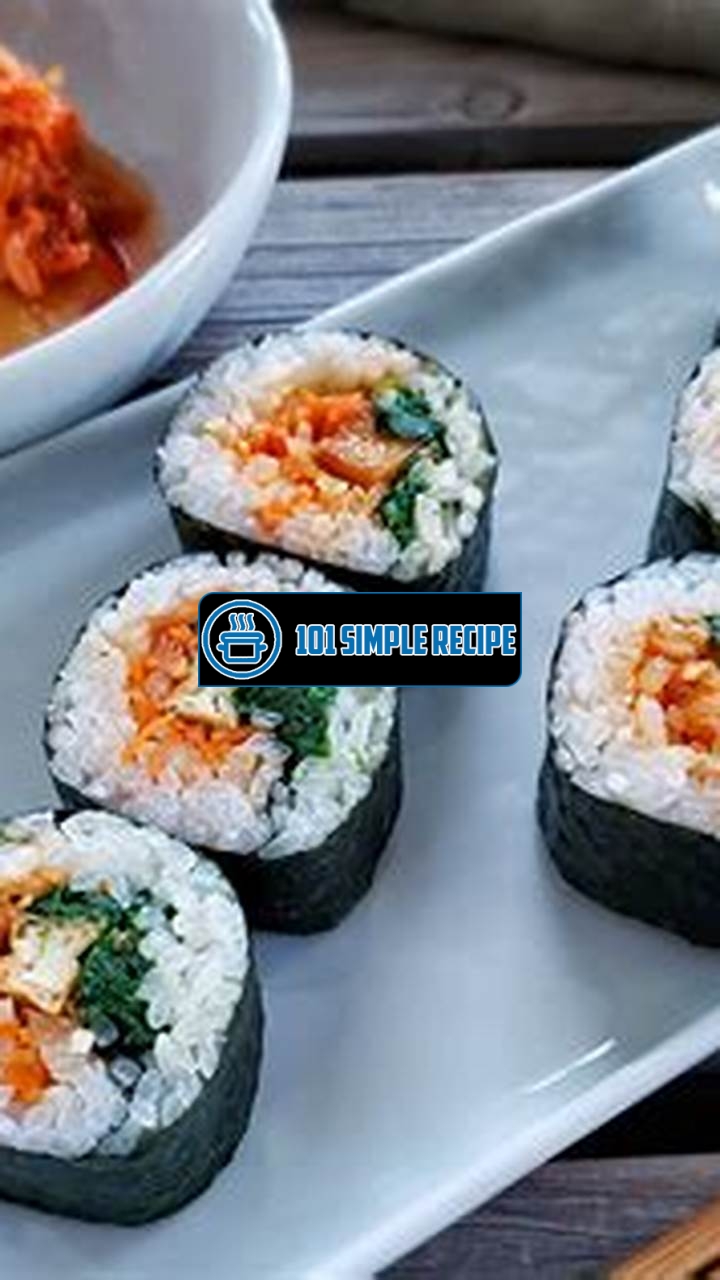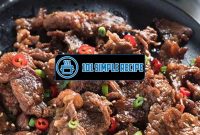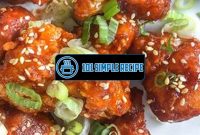If you crave a taste of Korea right in the comfort of your own home, look no further than this delicious Korean Seaweed Roll recipe. Made with a delicate combination of savory ingredients, this dish is sure to delight your taste buds and transport you to the vibrant streets of Seoul. Whether you’re a Korean food enthusiast or simply looking to try something new, this recipe is perfect for both beginners and experienced chefs alike. So grab your apron and get ready to roll – you won’t want to miss out on this culinary adventure!

Exploring the Versatile Korean Seaweed Roll Recipe
Uncover the secrets of the iconic Korean seaweed roll and discover the key components that make it a crowd-pleasing dish.
The Origin and Significance of Korean Seaweed Rolls
Korean seaweed rolls, also known as “gimbap” or “kimbap,” have a rich history and hold great significance in Korean cuisine. Dating back to the 19th century, seaweed rolls were inspired by Japanese sushi rolls but adapted to suit Korean tastes and ingredients. Today, they have become a beloved staple in Korean restaurants and homes around the world.
Seaweed rolls gained popularity in Korea as a convenient and portable meal option. They were originally made with vegetables, rice, and other ingredients available locally. The combination of flavors and textures, coupled with the ease of consumption, made these rolls an instant hit among Koreans.
What sets Korean seaweed rolls apart from other Asian roll variations is the use of gim, which refers to the dried seaweed sheets. Gim is a nutritious and flavorful ingredient that adds a unique taste to the rolls. It is typically roasted and seasoned with sesame oil and salt, giving it a crispy texture and umami flavor.
Furthermore, seaweed rolls are not just a tasty dish but also carry cultural significance. In Korean culture, they are often served during special occasions and celebrations such as weddings and birthdays. They symbolize joy, togetherness, and good fortune. The act of preparing and sharing these rolls brings people closer and fosters a sense of community.
The Essentials: Seaweed, Rice, and Fillings
When it comes to making Korean seaweed rolls, there are three essential components: seaweed, rice, and fillings. Let’s delve into each of these elements to understand their importance in creating a delicious roll.
1. Seaweed: The star ingredient of Korean seaweed rolls is the gim, or dried seaweed sheets. You can find these in Asian grocery stores or order them online. The gim adds a distinct flavor and plays a crucial role in achieving the perfect balance of textures in the roll. It provides a crispy bite and acts as a wrapper for the rice and fillings.
2. Rice: Rice forms the base of the seaweed roll and acts as a binding agent. It helps hold the ingredients together and provides a neutral taste that complements the other flavors. Traditionally, short-grain white rice is used, but you can also use brown rice or a mix of grains for a healthier twist.
3. Fillings: The fillings in Korean seaweed rolls are versatile and customizable. Common fillings include vegetables like carrots, cucumbers, and spinach, as well as proteins like bulgogi (marinated beef), tofu, or seafood. These fillings add a variety of flavors, colors, and textures to the rolls, making them visually appealing and delicious.
Note: Feel free to get creative with your fillings and experiment with different combinations to suit your taste preferences.
The Art of Rolling: Techniques and Tips
Rolling Korean seaweed rolls may seem intimidating at first, but with a few simple techniques and tips, you’ll master the art in no time. Here’s how to create perfectly rolled seaweed rolls:
- Prepare your workspace: Make sure you have all your ingredients, including the seaweed sheets, rice, and fillings, laid out and ready to use. Having everything within reach will help streamline the rolling process.
- Moisten your hands: Before handling the seaweed sheets, moisten your hands with a bit of water to prevent the rice from sticking to your fingers. This will make it easier to spread the rice evenly on the seaweed.
- Spread the rice: Take a seaweed sheet and place it on a clean surface. With your moistened hands, spread a thin, even layer of rice on the sheet, leaving a small margin at the top and bottom. Make sure not to apply too much pressure while spreading the rice.
- Add the fillings: Arrange your desired fillings in a single row, slightly below the center of the rice-covered seaweed sheet. Be mindful not to overcrowd the fillings, as it may make rolling more challenging.
- Roll it up: Start rolling the seaweed sheet tightly from the bottom, using your fingers to hold the fillings in place. Apply gentle pressure as you roll to ensure a tight and secure roll. Once rolled, use a sharp knife to cut the roll into bite-sized pieces.
Remember, practice makes perfect. Don’t be discouraged if your first few rolls aren’t perfect. With each attempt, you’ll improve your rolling skills and achieve beautifully rolled seaweed rolls.
Now that you have explored the versatility of Korean seaweed rolls, the origin and significance behind them, and the essential components needed to create a delicious roll, it’s time to roll up your sleeves and try making your own mouthwatering version. Whether you’re a seaweed roll enthusiast or a newbie to Korean cuisine, this recipe is sure to satisfy your taste buds and impress your friends and family.
Purchasing and Preparing the Ingredients
When it comes to making the perfect Korean seaweed roll, it all starts with purchasing and preparing the right ingredients. Here, we will delve into the essential components needed to create this delicious dish and guide you on how to properly prepare them.
Choosing the Right Seaweed
The first crucial step in making a Korean seaweed roll is selecting the right type of seaweed. In Korean cuisine, the most commonly used variety is known as “gim.” You can find this seaweed at most Asian grocery stores or order it online.
Make sure to check the freshness and quality of the seaweed before purchasing. Look for seaweed sheets that are dark green in color, have a slightly glossy appearance, and are free from any signs of dampness or discoloration. Fresh seaweed is essential for achieving the perfect taste and texture in your roll.
Perfecting the Rice Base
The next important component of a Korean seaweed roll is the rice base. In order to create a delicious and sticky rice, you’ll need to start by choosing the right type of rice. Sushi rice, also known as short-grain rice, is the preferred choice for this recipe.
Before cooking the rice, rinse it thoroughly a couple of times to remove any excess starch. This step ensures that the rice will not become too sticky. Once rinsed, cook the rice according to the instructions on the package.
After the rice is cooked, transfer it to a wide bowl and let it cool slightly before seasoning it with a mixture of rice vinegar, sugar, and salt. The vinegar adds a tangy flavor to the rice and helps it stick together when rolled. Mix the seasoning gently into the rice using a wooden spatula and let it cool completely before using it in your seaweed roll.
Delicious Fillings: From Traditional to Creative
Now comes the fun part – choosing the fillings for your Korean seaweed roll! Traditionally, a Korean seaweed roll includes a combination of vegetables, seafood, and meat. Some popular options include cucumber, carrot, egg, crab, and bulgogi (marinated beef).
If you’re feeling a bit more adventurous, you can get creative with your fillings. Experiment with different types of veggies, such as avocado, spinach, or bell peppers. You can also add a touch of sweetness with mango or add a spicy kick with kimchi.
When assembling your roll, make sure to cut the fillings into thin, long strips to ensure a uniform shape and easy rolling. Spread a thin layer of seasoned rice on the seaweed sheet, leaving a small border at the top. Arrange the fillings in a line across the rice and start rolling the seaweed tightly, using a bamboo sushi mat or your hands.
Make sure to apply gentle pressure as you roll to secure the ingredients together. Once the roll is complete, use a sharp knife to cut it into bite-sized pieces. Serve with a side of soy sauce and enjoy your homemade Korean seaweed roll!
Now that you have learned about the essential ingredients and preparation techniques, you are ready to embark on your Korean seaweed roll-making adventure. Get creative with your fillings and enjoy the delicious flavors of this iconic Korean dish!
Ranch oyster crackers recipe is a perfect snack to serve alongside your Korean seaweed rolls.
Mastering the Assembly and Presentation
When it comes to creating a delicious and visually appealing Korean seaweed roll, mastering the assembly and presentation is key. In this section, we will guide you through the step-by-step process of assembling the roll and explore creative ways to present this dish that will impress your guests.
Rolling Like a Pro: Step-by-Step Guide
To start, gather all the necessary ingredients for your Korean seaweed roll. These typically include seaweed sheets, sushi rice, various fillings such as cucumber, carrots, and tofu, and a dipping sauce like soy sauce or spicy gochujang.
First, place a sheet of seaweed on a clean surface. Spread a layer of sushi rice evenly on the seaweed sheet, leaving about an inch of space at the top. This will make it easier to roll the seaweed tightly.
Next, arrange your desired fillings in a neat line along the bottom edge of the seaweed sheet. It’s important to choose ingredients that complement each other in terms of flavor and texture. For example, you could combine crunchy carrots with creamy avocados or add a kick of heat with spicy kimchi.
Now comes the fun part – rolling the seaweed like a pro. Starting from the bottom edge where the fillings are, gently lift the seaweed and roll it over the fillings, applying light pressure to ensure a tight roll. Continue rolling until you reach the top, sealing the roll by lightly moistening the exposed seaweed with water.
Once the roll is complete, use a sharp knife to slice it into bite-sized pieces. For a neat presentation, dip the knife into water before each cut to prevent the rice from sticking. Arrange the sushi rolls on a serving platter, making sure to leave a bit of space between each piece for easy grabbing.
Cutting and Plating Techniques for Picture-Perfect Results
When it comes to cutting the Korean seaweed roll, precision is key for picture-perfect results. A sharp knife and a careful hand are your best tools for achieving clean and uniform slices.
Start by wiping the blade of your knife with a damp cloth to prevent any rice residue from sticking. Then, apply gentle, even pressure as you slice through the roll. If the knife starts to stick, you can moisten it again with water. Remember to clean the knife after each cut to maintain a clean presentation.
Once your rolls are perfectly sliced, it’s time to get creative with the plating. Use a beautiful serving platter or wooden sushi board as the base for your presentation. Arrange the sushi rolls in an eye-catching pattern, with different fillings and colors strategically placed to create visual appeal.
You can also add a touch of elegance to your presentation by garnishing the platter with edible flowers, sesame seeds, or thinly sliced vegetables. These small details can make a big difference in the overall visual appeal of the dish.
Garnishing and Sauces: Enhancing the Flavor and Visual Appeal
To enhance the flavor and visual appeal of your Korean seaweed roll, consider adding garnishes and serving it with delicious dipping sauces.
Garnishing with fresh herbs such as cilantro or chives can add a burst of freshness to the roll. Thinly sliced green onions or radishes can also provide a subtle crunch and vibrant color. Sprinkling toasted sesame seeds on top of the rolls can add a nutty flavor and a beautiful visual element.
When it comes to sauces, there are several options to choose from. Traditional Korean dipping sauces like soy sauce or spicy gochujang are excellent choices. You can also get creative and experiment with different flavors such as wasabi mayo or a tangy ginger sesame sauce.
Remember to place the dipping sauce in small bowls or ramekins alongside the sushi rolls for easy access. This not only enhances the flavor but also allows your guests to customize their experience.
In conclusion, mastering the assembly and presentation of the Korean seaweed roll is essential to create a visually appealing and delicious dish. By following the step-by-step guide, practicing precision in cutting and plating, and adding garnishes and sauces, you will be able to create a picture-perfect roll that will impress both your taste buds and your guests.
Exploring Variations and Fusions
Embark on a culinary adventure as we explore different variations and innovative fusions of the traditional Korean seaweed roll.
Vegetarian and Vegan Options
When it comes to Korean seaweed rolls, many people mistakenly assume they can only be enjoyed by meat lovers. However, there are plenty of vegetarian and vegan options that are just as delicious and satisfying. Instead of filling the rolls with fish or beef, try using ingredients like tofu, mushrooms, or a variety of colorful vegetables. These alternatives provide a burst of flavors, perfect for those following a plant-based diet.
Vegetarian and vegan options for Korean seaweed rolls offer a refreshing twist to the traditional dish while still maintaining its authentic taste and texture.
Fusion Flavors: Infusing Korean Seaweed Rolls with Global Cuisines
One of the most exciting aspects of Korean cuisine is its ability to fuse flavors from different culinary traditions. Korean seaweed rolls can be transformed into a global sensation by incorporating ingredients and techniques from other cuisines. For example, you can add a Mexican twist to your seaweed rolls by filling them with seasoned black beans, avocado, and salsa. Alternatively, you can try a Japanese-inspired fusion by using sushi rice and adding wasabi and pickled ginger to the filling. The possibilities are endless!
Infusing Korean seaweed rolls with global flavors allows you to explore new taste combinations and create unique culinary creations.
Miniature and Upscale Interpretations
While traditional Korean seaweed rolls are typically served in a larger size, there has been a growing trend of creating miniature versions of this beloved dish. These bite-sized rolls are perfect for appetizers or as part of a party platter. Additionally, upscale interpretations of Korean seaweed rolls have emerged, featuring high-end ingredients like lobster, truffle, and caviar. These luxurious variations elevate the dish to a whole new level of sophistication.
Trying out miniature and upscale interpretations of Korean seaweed rolls adds a touch of elegance and versatility to your culinary repertoire.
In summary, exploring variations and fusions of the traditional Korean seaweed roll opens up a world of possibilities. Whether you’re looking for vegetarian and vegan options, want to infuse global flavors, or try out miniature or upscale interpretations, there is a Korean seaweed roll to suit every palate and occasion. So go ahead, unleash your creativity in the kitchen and enjoy the delicious journey of experimenting with different flavors and styles.
Nature’s Recipe dog food is a great option for pet owners looking for a nutritious meal for their furry friends.
Enjoying the Korean Seaweed Rolls: Cultural Significance and Serving Suggestions
Learn about the cultural significance of Korean seaweed rolls and discover delightful ways to serve and enjoy this beloved dish. Korean seaweed rolls, also known as gimbap, are a popular dish in Korean cuisine. They are made with a combination of rice, vegetables, meat, and seaweed, rolled into a tight cylindrical shape. Gimbap holds a special place in Korean culture and is enjoyed on a variety of occasions such as picnics, festivals, and family gatherings. In this article, we will explore the cultural significance of Korean seaweed rolls and provide serving suggestions to enhance your dining experience.
Symbolism and Traditional Occasions
Korean seaweed rolls have deep cultural significance in Korea. The shape and ingredients of gimbap are symbolical and represent different aspects of life and tradition. The cylindrical shape of the rolls signifies unity, wholeness, and harmony. It is believed that consuming gimbap promotes a sense of balance and completeness. In Korean culture, gimbap is often prepared for special occasions such as Seollal (Lunar New Year) and Chuseok (harvest festival) as it is considered a symbol of good luck and prosperity.
During these traditional festivals, families gather together to make gimbap, sharing laughter and stories while preparing this delicious dish. The process of making gimbap is seen as a way to strengthen family bonds and pass down culinary traditions from one generation to another. The act of sharing and enjoying gimbap during these occasions brings people closer and creates a sense of togetherness.
Pairings: Side Dishes and Beverages
To complement the flavors of Korean seaweed rolls, it is common to serve them with a variety of side dishes and beverages. Side dishes, known as banchan, can include kimchi, pickled vegetables, and soybean sprouts. These side dishes add a range of flavors and textures to the meal, enhancing the overall dining experience. It is also common to serve gimbap with a dipping sauce made from soy sauce and vinegar, adding a tangy kick to each bite.
When it comes to beverages, many Koreans enjoy gimbap with traditional rice wine, called makgeolli, or with a refreshing cup of green tea. These beverages complement the flavors of gimbap and provide a well-rounded dining experience. Some people also prefer to pair gimbap with soft drinks or other types of Korean alcoholic beverages depending on personal preferences.
Presenting Korean Seaweed Rolls for Special Gatherings
For special gatherings or parties, it’s important to present Korean seaweed rolls in an appealing way. One popular method is to cut the rolls into bite-sized pieces and arrange them on a platter. This not only makes it easier for guests to enjoy, but it also creates an aesthetically pleasing display. Decorate the platter with fresh herbs or edible flowers to add a pop of color.
Another option is to serve gimbap in individual portions by wrapping each roll in a small sheet of parchment paper or aluminum foil. This allows guests to easily grab a roll without messing up the presentation. Additionally, you can provide an assortment of dipping sauces and condiments to customize the flavors of the gimbap.
In conclusion, Korean seaweed rolls hold significant cultural value and are enjoyed in various ways. Whether you are celebrating a traditional occasion or preparing a simple meal at home, gimbap is a versatile and delicious dish that can be enjoyed by everyone. Remember to explore different side dishes and beverages to enhance the flavors of gimbap, and don’t forget to present it in an attractive and inviting way for special gatherings. Enjoy the cultural significance and flavors of Korean seaweed rolls!
Weight loss recipe is another healthy and delicious option to try alongside your Korean seaweed roll recipe.
Frequently Asked Questions
Thank you for taking the time to read our article on the popular Korean seaweed roll recipe. Below, you’ll find some frequently asked questions (FAQs) to further enhance your understanding of this delicious dish. We hope you find them helpful! If you have any more questions, don’t hesitate to reach out.
| No. | Questions | Answers |
|---|---|---|
| 1. | What type of seaweed is typically used for Korean seaweed rolls? | The most commonly used seaweed for Korean seaweed rolls is called gim, which is a type of dried laver. It has a unique texture and taste that complements the filling ingredients perfectly. |
| 2. | What are some popular fillings for Korean seaweed rolls? | Popular fillings for Korean seaweed rolls include rice, seasoned vegetables, pickled radish, and thinly sliced meat or seafood. These ingredients provide a variety of flavors and textures in every bite. |
| 3. | Can I make Korean seaweed rolls ahead of time? | Yes, you can prepare the ingredients and assemble the rolls ahead of time. However, it is best to wait to cut the rolls until just before serving to maintain their freshness and prevent them from becoming soggy. |
| 4. | Are Korean seaweed rolls vegan-friendly? | Korean seaweed rolls can easily be made vegan by omitting or substituting the meat or seafood fillings with plant-based alternatives. The rice and seasoned vegetables provide a tasty and nutritious vegan option. |
| 5. | Are there any dipping sauces that pair well with Korean seaweed rolls? | Yes, there are several dipping sauces that complement the flavors of Korean seaweed rolls. Some popular options include soy sauce with wasabi, spicy gochujang sauce, and sesame oil with salt and pepper. |
| 6. | Can I store leftovers of Korean seaweed rolls? | While it’s best to consume Korean seaweed rolls fresh, you can store leftovers in an airtight container in the refrigerator for up to 2 days. However, note that the texture may change slightly and the seaweed could become less crispy over time. |
Thank You for Reading!
We hope you enjoyed learning about this flavorful Korean seaweed roll recipe. Don’t be afraid to get creative and experiment with different fillings to suit your taste. Whether you’re serving them as a snack, an appetizer, or a main dish, these rolls are sure to impress your family and friends. Remember to visit our website again for more exciting recipes and culinary inspiration. Happy cooking!
Jump to Recipe
Korean Seaweed Roll Recipe

Learn how to make a delicious Korean seaweed roll filled with rice, vegetables, and your choice of protein. This easy-to-follow recipe will guide you through the process of creating a traditional Korean dish that is both healthy and flavorful.
- Nori seaweed sheets
- Steamed rice
- Assorted vegetables (carrots, cucumbers, bell peppers)
- Protein of choice (thinly sliced beef, grilled chicken, or cooked shrimp)
- Sesame oil
- Soy sauce
- Rice vinegar
- Salt and pepper
- Gather all the necessary ingredients as listed above. Wash and slice the vegetables, and cook the protein according to your preference.
- In a small bowl, combine 2 tablespoons of soy sauce, 1 tablespoon of rice vinegar, 1 teaspoon of sesame oil, and a pinch of salt and pepper.
- Lay a sheet of nori seaweed on a sushi mat or a piece of plastic wrap. Spread a thin layer of steamed rice evenly on top, leaving a small border around the edges. Add your desired fillings, such as sliced vegetables and protein, on top of the rice. Drizzle a small amount of the seasoning sauce over the fillings.
- Using the sushi mat or plastic wrap, start rolling the seaweed away from you, applying gentle pressure to ensure a tight roll. Moisten the edges of the seaweed with water to seal the roll.
- Carefully slice the rolled seaweed into bite-sized pieces using a sharp knife. Repeat the process until all the ingredients are used.
- Arrange the sliced seaweed rolls on a serving platter and garnish with sesame seeds, if desired. Serve with dipping sauces and enjoy!






